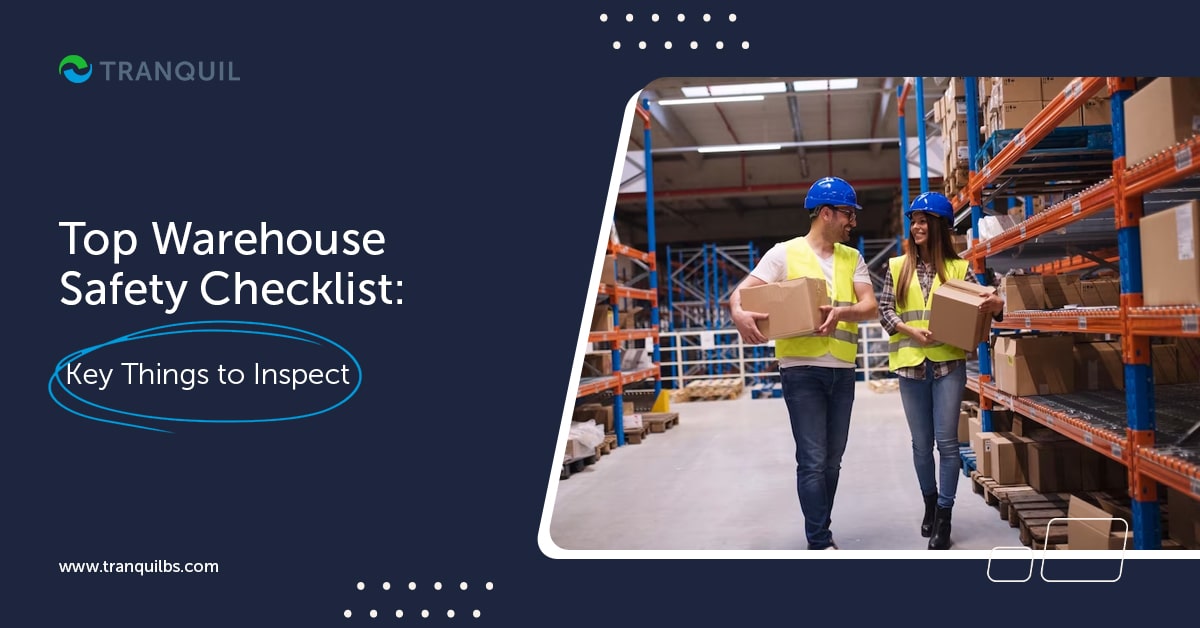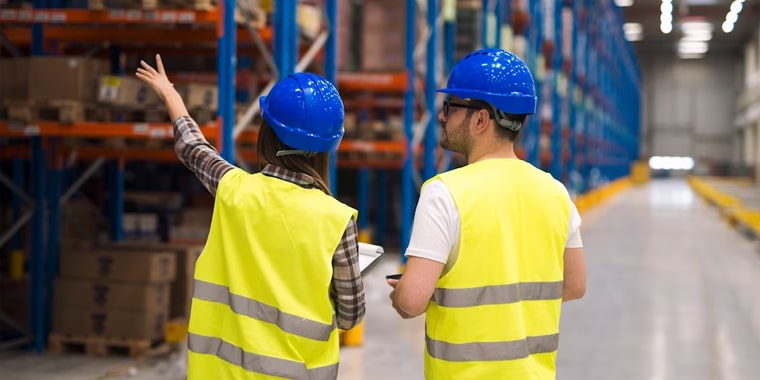
A safety checklist is used in a warehouse to help ops managers to recognize safety hazards, so that they can take the necessary precautions to prevent accidents at the workplace.
With warehouse employees facing numerous problems like very stressful environments, hazardous materials, and repetitive motions, a warehouse safety checklist has become a critical tool of managing safety in the warehouse.
The checklist can help managers ensure that all safety procedures have been conducted according to the safety policies to protect workers, and can also be used to record feedback.
The International Labor Organization reports that over 2.3 million employees have work-related accidents every year; the majority of these take place in the warehousing industry.
ALSO READ: Inventory Management Trends to Know
Common hazards faced by employees include:
Remember that if you compromise on safety to save money, you could be seriously endangering the lives of your employees; additionally, you will be violating compliance requirements, and may face hefty fines and litigation.

Though workplace injuries can take place anywhere, warehouses are riskier as there are huge loads, packages, and equipment for lifting and transporting goods, and so on, which employees have to operate.
ALSO READ: What is Inventory Reorder Point?
Forklift trucks are essential in any warehouse facility; but improper usage of this equipment can cause serious harm to their operators – even resulting in death – other employees, and property.
In fact, unsafe use of forklift trucks is the most commonly mentioned hazard in warehouse operations by industry safety watchkeepers.
Therefore, it is extremely important that strict safety provisions are followed in their use.
Workers can get trapped between a forklift truck and loading ramp inside the warehouse – one of the most horrible accidents they can have.
This happens when the truck leaves the dock and rams into a worker.
It is critical that personnel driving the forklift trucks are always alert, and drive slowly.
ALSO READ: What is Inventory Aging?
While these are very convenient to transport goods, they also pose serious injury risks to workers.
Employees can get caught in equipment and even get hit by falling objects.

Protective equipment for employees include safety shoes, hard hats, gloves, goggles, ear muffs (if environment is noisy) bright and high visibility jackets, and overalls that protect against mechanical and electrical hazards.
It is essential that warehouse workers are provided with whatever is required from among these for their safety.
Apart from these, it is vital that warehouses are regularly inspected so that problems can be identified before they blow up and cause damage.
Any leaks, cracks, and breaks should be immediately fixed.
No trash or debris should be allowed to accumulate anywhere.
All loose, dangling wires and cables should be secured as soon as they are noticed.
ALSO READ: What is Negative Inventory and How Can you Prevent it?
All equipment should be regularly checked and serviced, so that minor problems are identified and rectified before big problems develop, and cause loss of life and property.
It is not enough to have safety procedures and protective equipment in place.
These need to be checked regularly to ensure that they are in good working order, and they have to be placed in such a manner that they are easily seen and accessible in emergencies.
Furthermore, you have to ensure that your employees are properly trained on using equipment, and how to evacuate in the event of a fire, and other safety procedures.
The training should be refreshed at regular intervals so that your employees don’t forget what to do during emergencies.
You need to promote a culture of safety by always impressing on your workforce the importance of following procedure, getting certified, and so on for the sake of their own safety and that of their coworkers.
Maintaining the premises in a clean, neat, and hygienic manner is crucial, and may make the difference between a safe and unsafe working environment.
ALSO READ: What is Inventory Stock Valuation?

Ø Is there any damage to the windows, doors, walls, floors, and ceiling?
o If yes, mention details
Ø Is there any obstruction in the aisles, workstations, and exits?
Ø Are the vehicles in their designated positions?
Ø Are all electrical cords secured?
Ø Check if the following areas are well lit:
o Workstations
o Corridors
o Offices
o Loading docks
o Fire exits
o Lunch room
o Bathrooms
ALSO READ: A Complete Guide To Payroll Migration
Ø Is there any trash lying around? If yes, dispose immediately.
Ø Are workstations, break rooms, and washrooms clean and hygienic?
Ø Fire Safety
o Check fire extinguishers – are they in the right positions?
o Are all fire safety systems in working conditions:
o Sprinkler systems
o Fire alarms
o Hoses
o Check for risk of explosion in the event of uncontrollable fire
o Are chemicals stored safely and with fire-retardant covers?
Ø Is the ventilation adequate to ensure freedom from dust for the workers?
Ø Check Signage
o Are all fire exits well lit and with proper and prominent signage that allows them to be located in an emergency?
o Are markers that direct workers towards emergency and fire exits properly spread throughout the site?
o Are all emergency signs properly placed, and big and clear enough to be seen easily in the event of an emergency?
Ø Check Drainage Systems
o Is the drainage sufficient to prevent slips and keep paper dry?
o Are all drain pipes and ditches clear and without blockages?
o Are the rainwater gutters clear of debris?
ALSO READ: The Must-Have Modules and Features for an HRMS
Ø Is the labeling on hazardous materials in compliance with industry and government regulations?
Ø Check the aisles:
o Are the aisles wide enough to offer safe passage for forklifts?
o Can forklift operators perform their tasks with the propre safe clearances?
o Are all aisles in the warehouse clearly marked and identified, enabling workers to know where to store specific materials?
Ø Storage Racks
o Are all storage racks clean and damage-free?
o Are the racks stacked properly and safely in the storage areas?
o Is the height of the pile right so that goods bundles will stay without toppling?
Ø Is the loading bay safe?
o Are there any obstructions?
o Can the doors be opened smoothly?
o Check the forklifts and other vehicles – are they in working condition?
ALSO READ: What Is Cloud Data Protection?
Ø Inspect Staircases
o Are there proper railings in place? If not, they should be installed to prevent falls
o Are all staircases similar in height and design? If not, there should be sufficient warning to prevent workers from tripping because they expect staircases to be similar.
o Do the stairs have guardrails installed to prevent falls?
Ø Forklift truck safety
o Are all the forklift drivers properly trained and qualified?
o Have they undergone refresher training and evaluations?
o Daily inspection of forklifts is necessary prior to take-off to check for any damage
o Are the goods placed in the right manner before operations?
Ø Docks
o Check if docks are free of clutter
o Are dock edges safe for carrying loads?
o Are there adequate signs warning people to stay away from the docks?
o Set low speed limits and ensure forklift drivers stick to that in the area
ALSO READ: How Do ERP Systems Work?
Ø Conveyors
o Is there adequate protection provided between the conveyor belt and workers so that clothes or any part of the body or hair will not get tangled?
o Are the precise procedures for locking followed during repair and maintenance of the conveyor belt?
Ø Materials Storage
o Are the gangways and passages clear and well-maintained to prevent slips and falls?
o Are the loads positioned evenly and correctly?
o Are heavier loads stacked on the lower shelves
o Ensure that only one load is removed at a time
Ø Manual Lifting and Handling
o Is it possible to minimize the need for manual lifting?
o Can engineering design techniques be implemented to improve conditions and eliminate overexertion and unnatural movements?
o Are workers trained in the right ergonomic postures to maintain while moving loads, to prevent fractures and damage to muscles?
ALSO READ: Detailed Guide to Warehouse Automation
Ø Hazardous Chemical Safe Handling
o Is there a proper hazard communication program in place?
o Have the workers been properly trained to identify hazardous chemicals, handling, storing, and disposing them properly?
o Do they know the right protective equipment to be used for handling these chemicals
Ø Charging Stations used for refueling or recharging of driven equipment (petrol, LPG, or battery)
o Are they far away from all open flames?
o Are adequate fire extinguishers available and in good working order?
o Are ‘No Smoking’ Signs prominently displayed, and is this strictly implemented?
o Does the area have sufficient ventilation so that harmful gases are distributed?
o Do workers have facilities for eyewash and shower in the event of exposure to acids and chemicals?
o Are enough number of quality PPE sets available to the workers?
ALSO READ: Understanding Sales Management in ERP
Ø Equipment Under Voltage
o Has a proper lockout tagout program been implemented to shut down live equipment properly and prevent workers from getting trapped between machine parts or getting electrical shocks?
o Are all the employees working with such equipment properly trained on LOTO procedures, and in their use and removal post maintenance?
Ø Personal Protective Equipment – Are workers using the right PPE for the tasks they are performing?
Ø Are all the tools and equipment being inspected regularly? Is it properly documented?
Of course, there could be other matters that need to be checked, depending on the type of products your business deals in, and the type of warehouses you have. But these are the most important things you need to take care of.
Tranquil ERP is a powerful solution that can help you conduct and keep track of warehouse inspections, enabling you to maintain compliance with safety regulations and provide a positive work environment for employees. Do schedule a FREE demo to know how Tranquil can help your business – we are happy to answer all your queries.